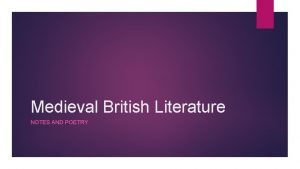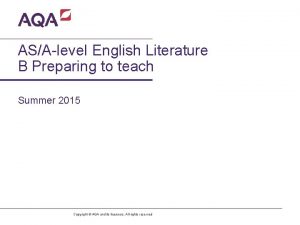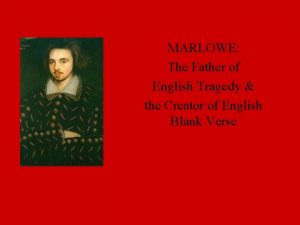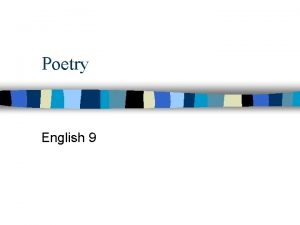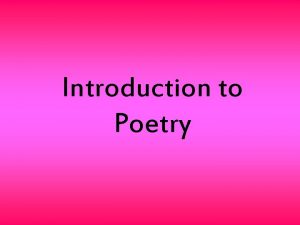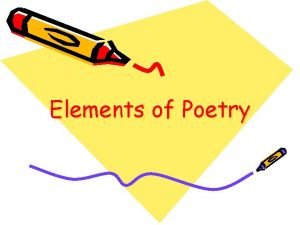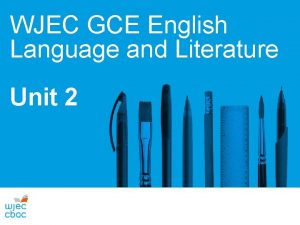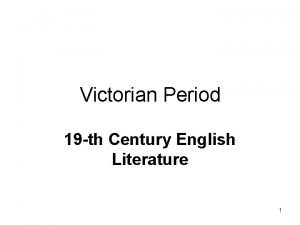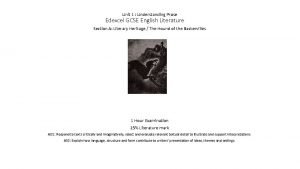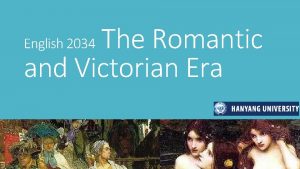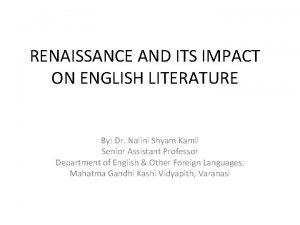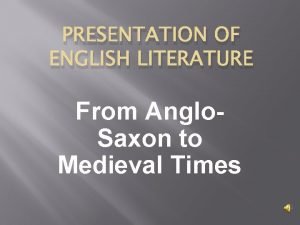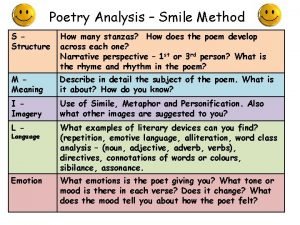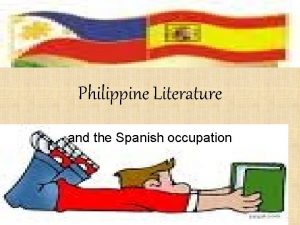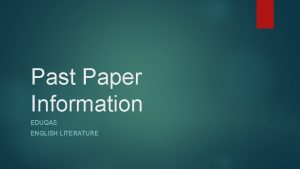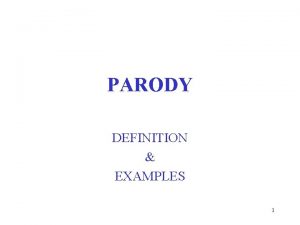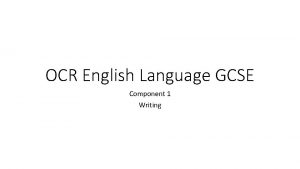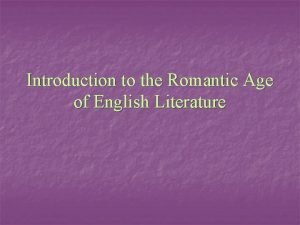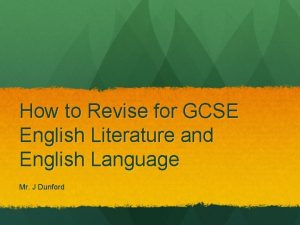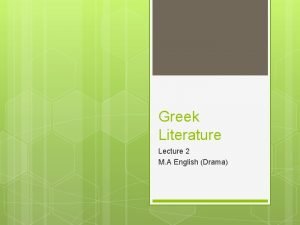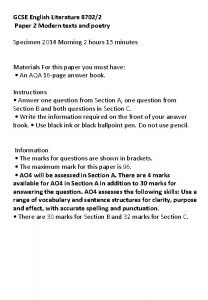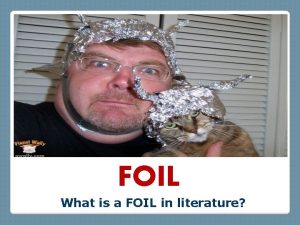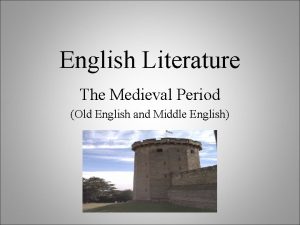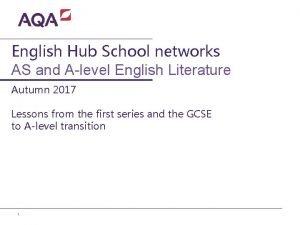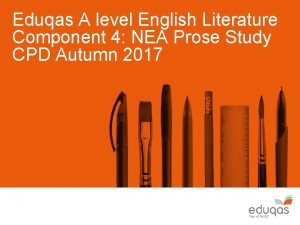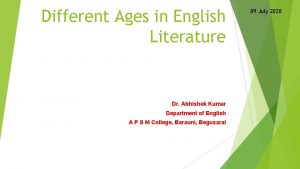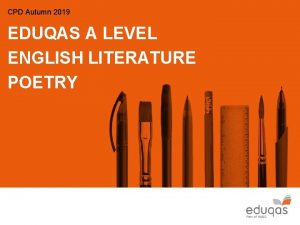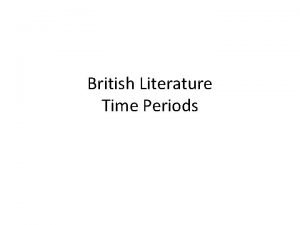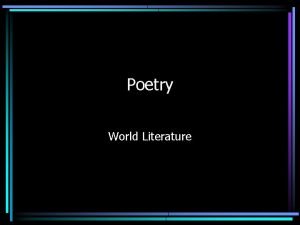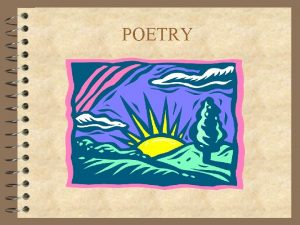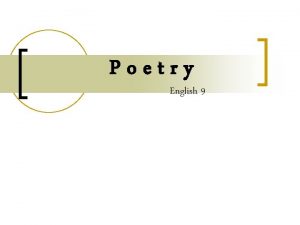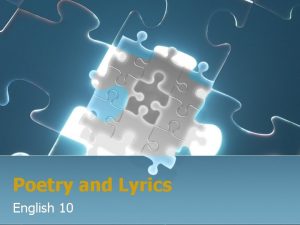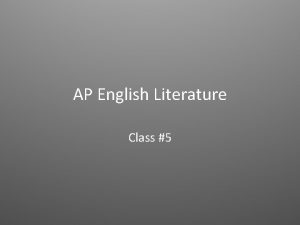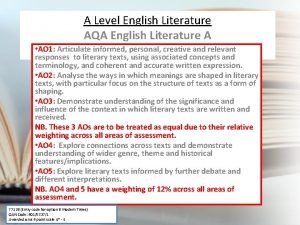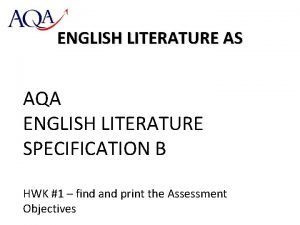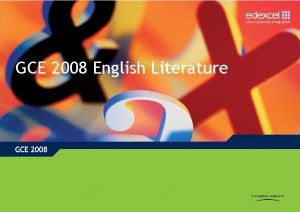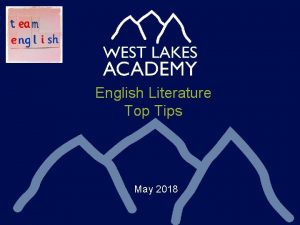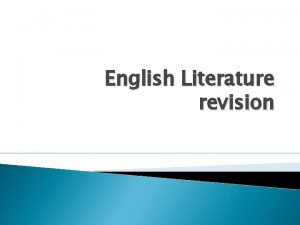Poetry English 9 What is Poetry literature that












![Metaphor • Something is something else. • Example: “[Love] is an ever fixed mark, Metaphor • Something is something else. • Example: “[Love] is an ever fixed mark,](https://slidetodoc.com/presentation_image/c98b5a9f8428619942cdb6f5a0c5ad8d/image-13.jpg)



































- Slides: 48

Poetry English 9

What is Poetry? • literature that is written in meter/verse • something that follows a particular flow of rhythm and meter • attempts to take rich, deep thoughts and “pack” them into a few words

Basic Terms of Poetry

Denotation • The dictionary definition of a word

Connotation • The implied or suggested meaning connected with a word.

Literal Meaning • Limited to the simplest, ordinary, most obvious meaning

Figurative Meaning • Associative or connotative meaning; representational

Meter • Measured pattern of rhythmic accents in a line of verse

Rhyme • Correspondence of terminal sounds of words or of lines of verse.

Rhyme • There are three main types of end-rhymes: • 1. True rhyme occurs exactly on one stressed syllable EX. car, far • 2. Two syllable rhyme uses words of more than one syllable and occurs when the accented syllable rhymes EX. buckle, knuckle • 3. Off-rhyme or Slant Rhyme occurs when words sound very similar but do not correspond in sound exactly EX. down, noon

Figurative Language of Poetry

Hyperbole • Exaggeration for emphasis (the opposite of understatement). • Example: “I’m so hungry I could eat a horse. ”
![Metaphor Something is something else Example Love is an ever fixed mark Metaphor • Something is something else. • Example: “[Love] is an ever fixed mark,](https://slidetodoc.com/presentation_image/c98b5a9f8428619942cdb6f5a0c5ad8d/image-13.jpg)
Metaphor • Something is something else. • Example: “[Love] is an ever fixed mark, / that looks on tempests and is never shaken. ”

Oxymoron • A combination of two words that appear to contradict each other. • Example: bittersweet/ army intelligence

Paradox • A situation or phrase that appears to be contradictory but which contains a truth worth considering. • Example: “In order to preserve peace, we must prepare for war. ”

Personification • Giving inanimate objects or abstract concepts living qualities. • Example: “Time let me play/ and be golden in the mercy of his means. ” “The trash can tossed its guts on the floor. ”

Simile • Comparison between to essentially unlike things using words such as “like, ” “as, ” or “as though. ” • Example: “My mistress’ eyes are nothing like the sun. ”

Poetic Devices

Irony • A contradiction of expectation between what is said and what is meant (verbal irony), or what is expected in a particular circumstance or behavior (situational), or when a character speaks in ignorance of a situation known to the audience or other characters (dramatic). • Example: “Time held me green and dying Though I sang in my chains like the sea. ”

Imagery • Word or sequence of words representing a sensory experience (Visual, auditory, olfactory, tactile, and gustatory). • Example: “bells knelling classes to a close” auditory

Symbol • An object or action that stands for something beyond itself. • Example: White = innocence, purity, hope

Alliteration • The repetition of consonant sounds, particularly at the beginning of words • Example: “…like a wanderer white. ”

Assonance • The repetition of similar vowel sounds. • Example: “I rose and told him of my woe. ”

Onomatopoeia • The use of words to imitate the sounds they describe. • Example: Crack or whip

Allusion • A reference to the person, event, or work outside the poem or literary piece. • Example: “Shining, it was Adam and maiden. ”

Form of Poetry

Open • Poetic form free from regularity and consistency in elements such as rhyme, line length, and metrical form.

Closed • Poetic form subject to a fixed structure and pattern.

Stanza • Unit of a poem often repeated in the same form throughout a poem; a unit of poetic lines (“verse paragraph”)

Blank Verse • Unrhymed iambic pentameter.

Free Verse • Lines with no prescribed pattern or structure.

Couplet • A pair of lines, usually rhymed

Quatrain • Four line stanza or grouping of verse

Sonnet • Fourteen line poem in iambic pentameter with a prescribed rhyme scheme; its subject is traditionally that of love.

English (Shakespearean) Sonnet • A sonnet probably made popular by Shakespeare with the following rhyme scheme: abab cdcd efef gg

METER Measured pattern of rhythmic accents in a line of verse

Stress • Greater amount of force used to pronounce one syllable over another.

Foot • A group of 2 or 3 syllables forming the basic unit of poetic rhythm

Rising meter • Meter containing metrical feet that move from the unstressed to stressed syllables.

Falling Meter • Meter containing metrical feet that move from stressed to unstressed syllables

Iambic (iamb) • A metrical foot containing two syllables -- the first is unstressed, while the second is stressed

Iambic Pentameter • A traditional form of rising meter consisting of lines containing five iambic feet (and, thus, ten syllables)

Other Important Pieces • Theme - what the poem is all about • theme of the poem is the central idea that the poet wants to convey • it can be a story, or a thought, or a description of something or someone • Mood—the predominant emotion, attitude, tone, or atmosphere of a piece of literature

Strategies for Reading Poetry • Preview the poem—notice the poem’s form: its shape, length, title (why did the poet choose that particular title? ) length of its lines, and whether or not it has stanzas. • Visualize the images—in your mind’s eye, picture the images and comparisons the poem makes. Do the images remind you of feelings or experiences you have had? • Try to figure out theme/main idea—ask yourself, “What’s the point of this poem? What message is the poet trying to send or help me create? Why did the poet write this poem in the first place? ”

Strategies for Reading Poetry • READ AND REREAD THE POEM UNTIL YOU UNDERSTAND—much “heavy reading” must be pondered and thought about over and over again until it is understood. If some of the most intelligent people in the world have to reread literature in order to understand it, don’t you think that you have to? • Above all: Enjoy and have fun! Put yourself in the “puzzle” mode trying to figure out what the poem’s message is.

Where the Sidewalk Ends by Shel Silverstein • There is a place where the sidewalk ends And before the street begins, And there the grass grows soft and white, And there the sun burns crimson bright, And there the moon-bird rests from his flight To cool in the peppermint wind. Let us leave this place where the smoke blows black And the dark street winds and bends. Past the pits where the asphalt flowers grow We shall walk with a walk that is measured and slow, And watch where the chalk-white arrows go To the place where the sidewalk ends. Yes we'll walk with a walk that is measured and slow, And we'll go where the chalk-white arrows go, For the children, they mark, and the children, they know The place where the sidewalk ends.

Dream Deferred by Langston Hughes • What happens to a dream deferred? Does it dry up Like a raisin in the sun? Or fester like a sore-And then run? Does it stink like rotten meat? Or crust and sugar over-like a syrupy sweet? Maybe it just sags like a heavy load. Or does it explode?

Six Traits of Poetry Writing • 1. The Idea – the heart of your poem, point of your message • 2. The Organization – the internal structure • 3. The Voice – evidence of the writer behind the message • 4. The Word Choice – the vocabulary or terminology used • 5. The Fluency – the rhythm and flow how it plays to the ear • 6. The Form – the mechanical structure and correctness there of
 Ngoại tâm thu thất chùm đôi
Ngoại tâm thu thất chùm đôi Block xoang nhĩ
Block xoang nhĩ Thể thơ truyền thống
Thể thơ truyền thống Thơ thất ngôn tứ tuyệt đường luật
Thơ thất ngôn tứ tuyệt đường luật Chiến lược kinh doanh quốc tế của walmart
Chiến lược kinh doanh quốc tế của walmart Tìm vết của đường thẳng
Tìm vết của đường thẳng Hãy nói thật ít để làm được nhiều
Hãy nói thật ít để làm được nhiều Tôn thất thuyết là ai
Tôn thất thuyết là ai Gây tê cơ vuông thắt lưng
Gây tê cơ vuông thắt lưng Sau thất bại ở hồ điển triệt
Sau thất bại ở hồ điển triệt Medieval poetry notes
Medieval poetry notes English lit paper 1 edexcel
English lit paper 1 edexcel Aqa a level english literature b past papers
Aqa a level english literature b past papers Yesterday and those winter sundays comparison
Yesterday and those winter sundays comparison Ac swinburne appreciated marlowe as father of english
Ac swinburne appreciated marlowe as father of english A fourteen line poem with prescribed rhyme of scheme
A fourteen line poem with prescribed rhyme of scheme Poetry vs prose
Poetry vs prose Elements and characteristics of poetry
Elements and characteristics of poetry Sensory language definition
Sensory language definition English literature wjec
English literature wjec Wjec past papers english literature a level
Wjec past papers english literature a level Eduqas english language a level
Eduqas english language a level Victorian period in english literature
Victorian period in english literature Edexcel gcse english literature
Edexcel gcse english literature Victorian age introduction
Victorian age introduction Victorian period in english literature
Victorian period in english literature University wits
University wits Characteristics of renaissance
Characteristics of renaissance Anglo saxon presentation
Anglo saxon presentation Structure of poetry
Structure of poetry Korido meaning
Korido meaning English literature paper 1 eduqas
English literature paper 1 eduqas Parody poem definition
Parody poem definition Language book
Language book Romantic age in literature
Romantic age in literature Importance of literature
Importance of literature How to revise for english literature gcse
How to revise for english literature gcse Hl essay checklist
Hl essay checklist Greek drama in english literature
Greek drama in english literature Modern text english literature
Modern text english literature Foil in english literature
Foil in english literature Characteristics of medieval english literature
Characteristics of medieval english literature Aqa english literature nea prohibited texts
Aqa english literature nea prohibited texts Is english lit and language separate gcses
Is english lit and language separate gcses Yesterday poem by patricia pogson analysis
Yesterday poem by patricia pogson analysis Eduqas a level english literature
Eduqas a level english literature Different ages of english literature
Different ages of english literature Eduqas english literature a level past papers
Eduqas english literature a level past papers Old english period historical background
Old english period historical background










